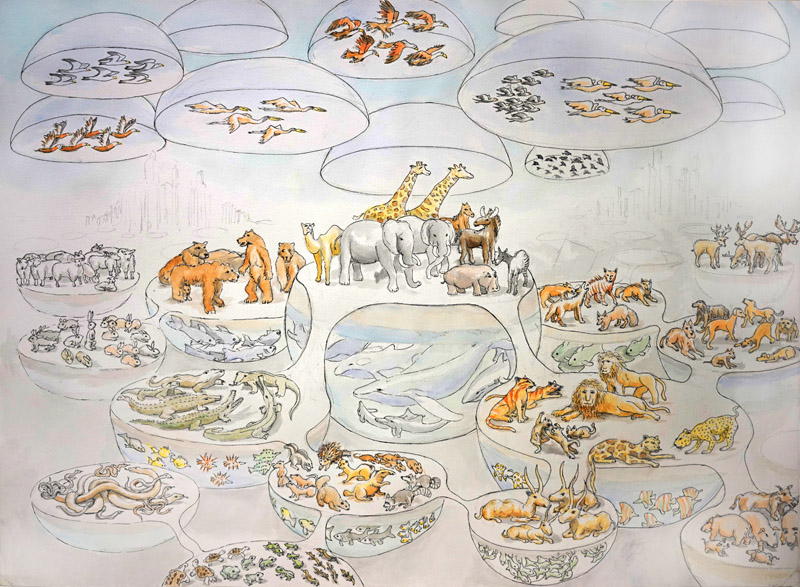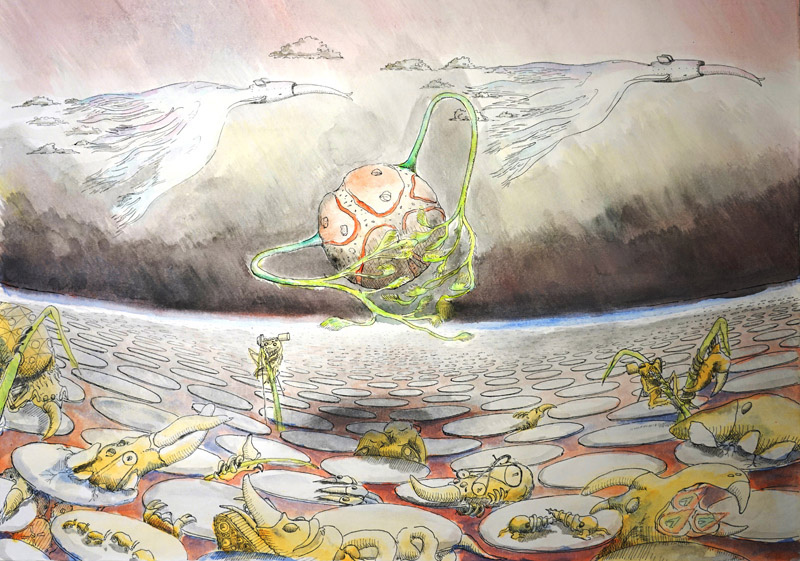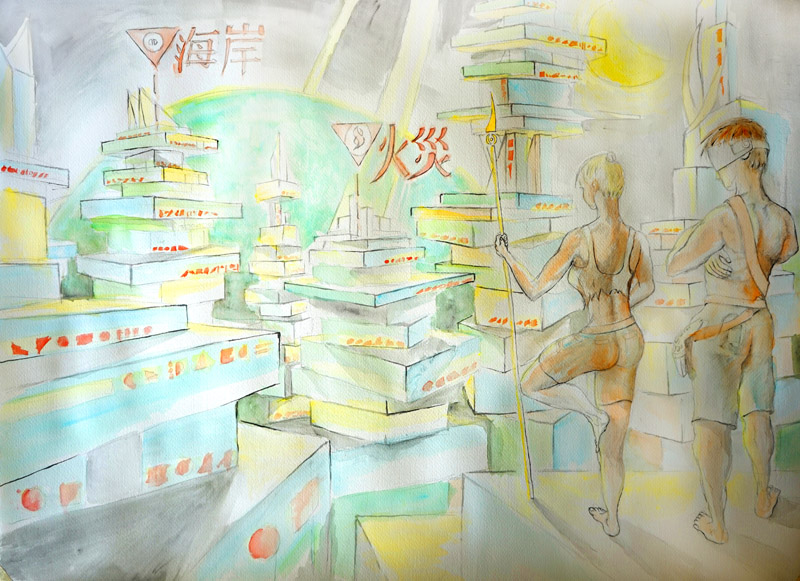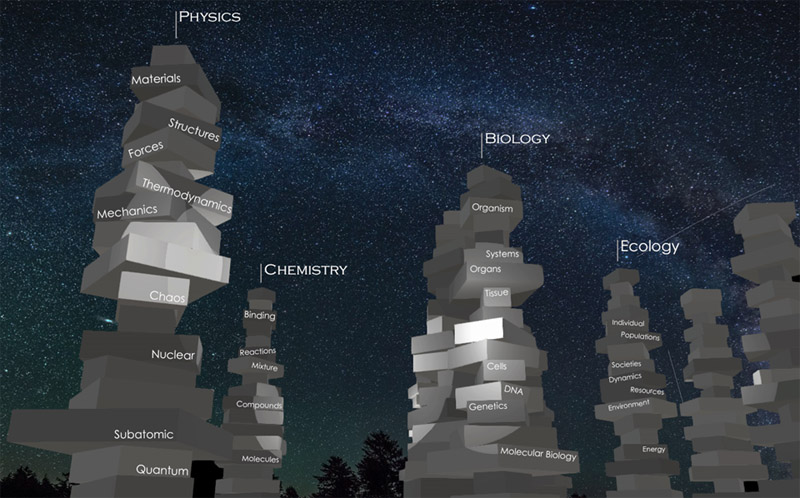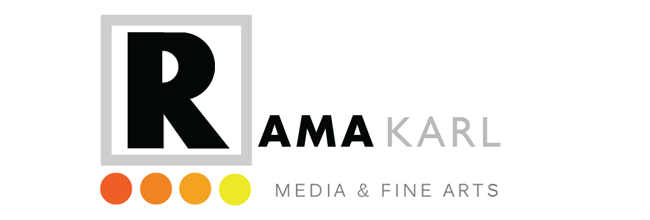Sentient Art developed from a five year struggle to redefine meaning in traditional painting media. During this period, canvases remained unpainted while drawings and sketches were used to consider and resolve issues in contemporary art. The following pre-cursors document that journey…
Relation to Science

Figure 2. This early scientific work, from 1998, contains some of the basic elements of later Sentience – empty landscapes, the use of space as a flattening device. But there are no symbols, the ants and bees are merely scientific objects here.
One value of art which distinguishes it from science is to attempt to synthesize social and human meaning. While science discovers the world through the documentation of objects, Sentient Art seeks to record meaning through the creation of new metaphors and symbolism. Yet Sentient Art is not photo-realistic. It creates new symbols that exaggerate, highlight or interconnect the observed reality.
Sentient Art is not Spiritual

Figure 3. Sentient art is not spiritual. This drawing dates from roughly 2012, as my inspiration toward simplicity led to native or traditional metaphors. However, I found these experiments to be either too religious or craft-like as they appropriate other cultures. This led me to actively seek a new and different style. I realized that the symbols I seek must be every day and common.
The symbolism of Sentient Art is metaphorical, not spiritual. Religious or Spiritual art uses symbols to guide our beliefs in universal beings, spirit or soul. Sentient symbols do not address topics of faith. The plant depicted is a real object but also a globally meaningful one. Fossil fuels, oil, is a real substance, the physical impacts of which are felt by all cultures. The roar of a jet engine is a tangible and visible flame. Sentient art searches for new, real, global metaphors to understand human perspectives of the modern world.
Similarity and Differences to Lowbrow and Pop

Figure 4. A strong theme in the search for a new style was a rejection of modern Pop Surrealism and Lowbrow. This work from 2001, while studying in Italy, is busy and cartoonish. The TV cameras and cars reference consumer culture. Whereas the origin of Lowbrow was to draw attention to excess consumerism, I believe that continued self-reference and appropriation of Lowbrow reinforces rather than questions consumer culture. Sentience was a search for a new, non-referential symbols.
Pop Art and Lowbrow draw attention to the modern world through cultural criticism and reflection, often via hyper-reference. They focuses our attention on the absurdity of consumerism by re-mixing, conflating, and borrowing commercialized objects. Sentient Art differs significantly in that it seeks new metaphors to explain connected, real aspects of daily life. While both art forms share the goal of understanding the modern world, Pop Art does this through cultural reference to appropriated symbols, whereas Sentient Art does this by continually seeking new symbols that are non-appropriated, global, and present in everyday life.

Simplification is a new technique that allows us to de-appropriate symbols. The rocket flame gives an example. Sentient art does not show a specific type or model of rocket, not a brand, nor the use of rockets as spectacle – the flame may be separated from the rocket. Present in daily life, the shape of the flame itself is a new modern symbol. The jet flame is a real experience, with new layers of meaning and emotion not present in historic times.
Beyond Personal Expression

Figure 5. The Birth of Icarus. Watercolor on paper. This work is a pre-cursor to Sentient Art in which the ‘visor’ first appears. Initially a device for VR, I found that it came to represent something more: a symbol for a common emotional escape from reality. The visor enables sight yet covers our eyes.
With a background in media arts, how can I explore traditional media with ideas that are new yet non-technical? This was initially a personal struggle. Surrounded like a kraken, what web of technology must be untangled to proceed. I have the tools of technology at my fingertips but I wish not to use them. While deeply invested art is always a personal struggle I was seeking general answers not tied to my own history. This led to the documentary nature of my new works and away from romantic or gothic themes.
Inspirations from Mexican Muralism

Figure 6. I view
Mexican muralism as containing many of the themes Sentient art. Unlike the hyper-exaggerated icons of Lowbrow, muralism attempts to depict a shared daily life. Sentient art further reduces the social, busy aspect, clearing the social space of the city to examine humanity at a global scale. In this work, from around 2014, cars and tanks sit overturned as isolated symbols.
Sentient Art does not have a political or consumer agenda, other than to bring awareness to our global, shared condition. Its goal is to document and record modern symbols. Similar to Mexican Muralism, e.g. Diego Rivera or Jose Orozco, this work reveals wealth inequality and consumption, but also compassion and the beauty of nature. Sentient art does not emphasize suffering to make a political point, but looks to place our own human perspective on the proper scale with each other, with other cultures, and with the natural world. Sentient art is intended as a road map of global human connection.
Relation to Surrealism

Figure 7. Surrealism attempts to reveal our psychic and dream reality. The pre-cursor sketch here has similar themes. Yet moving forward I did not wish to repeat these dream studies, but return to a study of our conscious, daily reality. Sentient art explores new symbols that connect our lived reality.
The popular image of Surrealism is Salvador Dali, known for his work exploring psychology and dreams through imaginary liquid forms. Yet the early visual surrealists, Miro, Masson, Tanguy and others were seeking to deconstruct illusion to convey the psychic reality of life, the “real functioning of thought.” Dali was an outcast among them as he rebuilt the illusion of form. Sentient Art is closer to original Surrealism, but not derived from it, in that it shares a goal of depicting a type of human truth without illusion. The style of Sentience explores symbols of modern life through simplification – removing illusion, appropriation, spectacle, and surface to seek the pure elements of human reality, and connect these with other global symbols.
The outcome of this journey is the style and process of Sentient Art.
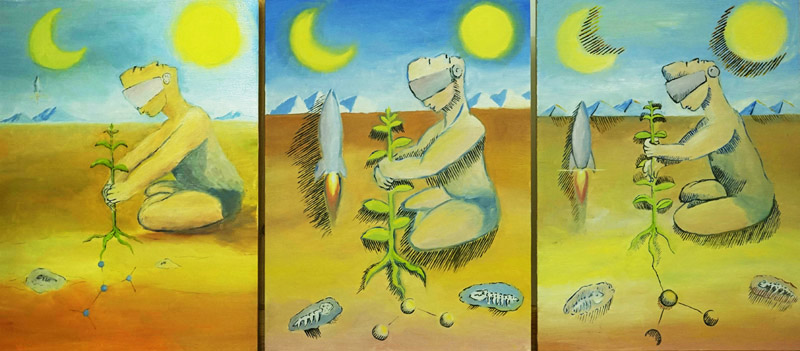
Sentient Art explores a new visual theme to document and record meaning in the modern era.
Sentience is the capability to reason, to feel, and to be globally aware. I seeks symbols and metaphors to understand modern life on a global scale – the rocket flame, the living plant, the fossil. Sentience moves away from illusory or pop surrealism to discover fundamental everyday symbols that connect us. Similar to the original surrealists which sought the “real functioning of human thought”, Sentient Art seeks direct symbols of modern reality to understand our shared connections and suffering across cultures.
Sentience seeks a new visual perspective on global change.
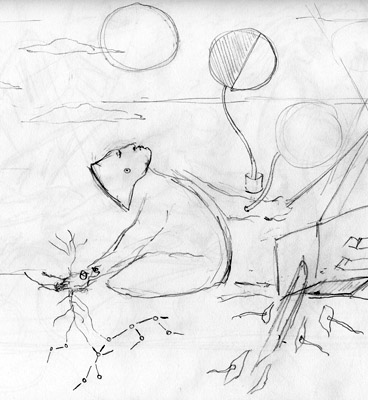
Untitled. Sentient art. Drawing on paper. 2015
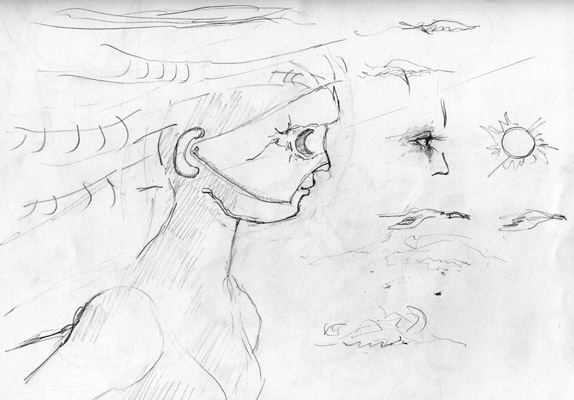
Seeing the Future. Sentient Art. Drawing on paper. 2017
I consider these to be the first fully realized works of Sentient Art. The origin of this work begins in 2011, as I was seeking to move away from technology-based media and rediscover my purpose in the visual arts. The initial realization was that I wanted to move away from pop surrealism, from the paradoxes of commodified lowbrow art. Large scale, unpainted canvases rested in my studio for five years. By 2015, after many sketches, this new work resolved the issues of appropriation and symbolism that I struggled with. The process of symbolic simplification, among other techniques, allows us to remove spectacle, and identify the shared symbols that are present everywhere in the daily life of our modern world.
For more background, see the related page on:
Pre-Cursors to Sentient Art: Background & Context.
New works to be exhibited at FM Oakland studio in Oakland, CA through 2019.
